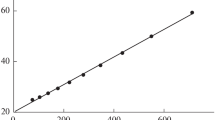Abstract
The formation of the AgCl phase in technical photochromic glasses is investigated using a model sodium borate glass. The temperature dependence of the solubility of AgCl in the melt is established and the solubility data are interpreted by a simple variant of the theory of regular solutions and thus the thermodynamic driving force of the process is determined. The kinetics of nucleation, growth and overall phase formation are followed by X-ray methods, electron microscopy and nephelometry. The formation of the AgCl-phase in the model melt can be described as a process of binodal liquid phase separation. The initial stages of this process display the characteristic features of non-steady state nucleation. In the advanced stages of AgCl formation saturation regions in Ostwald ripening curves are observed which cannot be explained by the theory of Lifshitz-Slyozov developed for a Newtonian fluid while glass forming systems behave near Tg as viscoelastic systems. The general validity of the results obtained for the present system is discussed and analogies with AgCl segregation in other photochromic glasses is discussed. The quantitative description of Ostwald ripening in viscoelastic media is attempted in a following contribution.
Similar content being viewed by others
References
V. A. TSEKHOMSKII, Fizika Khim. Stekla 4 (1978) 3.
R. J. ARAUJO, Contemp. Phys. 21 (1980) 77.
G. GLIEMEROTH, Glastechn. Ber. 54 (1981) 77.
L. FERLEY, T. MATTERN and G. LEHMANN, J. Non-Crystalline Solids 92 (1987) 107.
H. BACH and G. GLIEMEROTH, Glastechn. Ber. 44 (1971) 305.
I. FANDERLIK and L. PROD’HOMME, Verres et Refract. 27 (1973) 97.
I. FANDERLIK, Sklar a Keram. 23 (1973) 165.
J. J. HAMMEL and T. E. MCGARY, in “Reactivity of Solids”, edited by J. W. Mitchell (Wiley, New York, 1969) p. 695.
G. S. GALAKHOVA, N. M. PAVLUSHKIN and M. V. ARTAMONOVA, Trudy Mosk. Khim. Techn. Inst. im. Mendeleeva 63 (1969) 8.
G. TAMMAN, “Der Glaszustand” (L. Voss Verrlag, Leipzig, 1933).
I. GUTZOW, Contemp. Phys. 21 (1980) 121.
R. R. SHAW and D. R. UHLMANN, J. Amer. Ceram. Soc. 51 (1968) 377.
W. SKATULLA, W. VOGEL and H. WESSEL, Silikattechn. 9 (1958) 51.
M. H. C. BAETEN, H. N. STEIN and J. M. STEVELS, Silicates Ind. 37 (1972) 33.
R. PASCOVA and I. GUTZOW, Phys. Chem. Glasses 27 (1986) 140.
R. PASCOVA, I. GUTZOW and J. SCHMELZER, J. Mater. Sci. 25 (1990) 920.
R. PASCOVA and I. GUTZOW, Glastechn. Ber. 56 (1983) 324.
D. S. BELYANKIN, V. V. LAPIN and N. A. TOROPOV, “Fiziko-khimitsheskie Systemi Sieikatnoi Tekhnologii” (Promstroiizdat, Moskva, 1954) p. 50.
R. BECKER, Ann. Phys. 32 (1938) 128.
M. VOLMER, “Kinetik der Phasenbildung” (Th. Steinkopf, Dresden-Leipzig, 1939).
M. KAHLWEIT, Z. Phys. Chem. NF 28 (1961) 245.
S. V. NEMILOV, Neorg. Mater. 2 (1966) 349.
O. V. MAZURIN, M. V. STRELZINA and T. P. SHVAIKO-SHVAIKOVSKAYA, “Svoistva Stekol i Stekloobrazuyushtich Rasplavov” (Nauka, Leningrad, 1975) Vol. 2, p. 135.
A. TAYLOR, “X-ray Metallography” (Wiley, New York, 1965) Ch. 2.
A. GUINER, “Theorie of Technique de la Crystallographie”, 2nd edition (Dunod, Paris, 1956) p. 68.
A. A. SHISHKLOVSKII, “Prikladnaja Optika (Fizmatgiz, Moskva, 1961) p. 705.
C. V. DAVIES and G. H. NANCOLAS, Trans. Farad. Soc. 51 (1955) 823.
N. S. ANDREEV, O. V. MAZURIN, E. A. PORAIKOSHITZ, G. P. ROSCOVA and V. N. FILIPOVITSH, “Yavleniya Likvatzii v Steklach” (Nauka, Moskva, 1974).
I. M. LIFSHITZ and V. V. SLYOZOV, J. Phys. Chem. Solids 19 (1961) 35.
E. M. LIFSHITZ and L. P. PITAEVSKI, “Fizitsheskaja Kinetika” (Nauka, Moskva, 1979) p. 509.
C. WAGNER, Zs. Elektrochem. Ber. Bunsenges. Phys. Chem. 65 (1961) 581.
M. REINER, in “Rheology, Theory and Applications”, edited by F. R. Eirich, Vol. 1 (Academic Press, New York, 1956) Ch. 2.
T. ALFREY, “Mechanical Behaviour of High Polymers” (Interscience, New York, 1955) p. 53.
A. M. FREUDENTHAL, “Inelastic Behaviour of Engineering Materials and Structures” (Wiley, New York, 1955) Ch. 6.
W. L. WILLKINSON, “Non-Newtonian Fluids” (Pergamon Press, London, 1960).
Author information
Authors and Affiliations
Rights and permissions
About this article
Cite this article
Pascova, R., Gutzow, I. & Tomov, I. A model investigation of the process of phase formation in photochromic glasses. J Mater Sci 25, 914–920 (1990). https://doi.org/10.1007/BF03372179
Received:
Accepted:
Published:
Issue Date:
DOI: https://doi.org/10.1007/BF03372179




